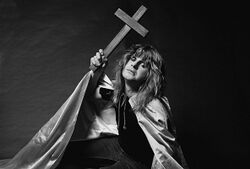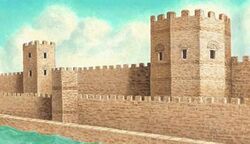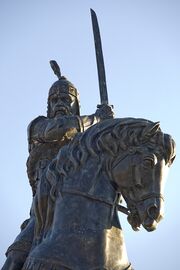Leo V
Leo V, also known as Leo the Armenian (this not being a compliment[1]) or Leo the Non-Cowardly Lion, was the Byzantine Emperor from 813 to 820. He was a soldier and an avid fan of breaking things. This included religious icons, making him an iconoclast. His imperial rival in the West, Emperor Louis the Pious, described him as an 'able thug.'
Background[edit]
Leo was born in the 750s, during the reign of his military hero, emperor Constantine V. His father Bardas (some spell this Badass) claimed descent from the Armenian royal family. Young Leo just wanted to be a soldier and made friends with a couple of other officers, Michael the Amorian (later emperor Michael II) and Thomas 'Tommy' the Slav (later a rebel emperor). They looked out for each other — likely from some military college fraternity oath — as they climbed the ladder toward the cushiest jobs in the Byzantine Empire.
Leo first appeared as a rebel supporting an opponent of emperor Nikephoros I in the early 800s. He switched sides and was rewarded with two spare imperial palaces on the eastern frontier. Leo then married Theodosia — an unwise match, as her father Arsaber (son of Arsewipe) was a serial rebel. Nikephorus cut short the rebellion and also cut short Leo's hair, making his humiliation more visible.[2] He also took back Leo's palaces, throwing him back on the street, and with a hungry family to feed. Luckily for Leo, Michael and Thomas helped out to prevent starvation.
Since Leo was posthumously damned by the Orthodox Church for his adherence to iconoclasm, there are plenty of other uncomplimentary stories about him too. It was alleged he ran away from the Arab armies and hid in Nicaea for the next few years. However, following the death of Nikephoros and most of his army in 811, the Byzantine empire was short of military officers. Leo got his job back.
Emperor[edit]
After Leo's reinstatement, he, Micky, and Tommy sidled up to emperor Michael I. The latter was planning to avenge the death of his father-in-law Nikephoros at the hands of the Bulgarian Khan Krum. Whatever the careful planning was, Leo wasn't encouraged by Michael's leadership. The army clashed with Krum's and were soon losing — despite being twice the size of the barbarian horde. Leo decided Michael was a loser and 'retreated in good order' (his account) or 'fled like a coward' (official Byzantine report[3]), leading to the loss of the battle. Leo could have expected a second demotion or worse, but his soldiers viewed retreat as the better part of valour, and Emperor Michael as not valourous at all.
Emperor Michael resigned in favour of Leo, who allocated him a monastery to live out his life in celibacy. Preemptively solving the problem of future loose claims to the throne in the Byzantine way, his sons were relieved of their baby-making equipment and were dropped off in other religious establishments. Leo's mates Michael and Thomas were rewarded with lucrative jobs as well. However, Krum was still on the loose. Leo suggested to his close friends that the empire use its reputation for duplicity and deceive the animal-skin-clad Krum.
Operation Krum Killer[edit]
Before heading off to deal with Krum, Leo crowned his eldest son Symbatios co-emperor, in case anything went wrong. The lad was barely 11, so the move mostly just formalized Theodosia's control of the cheque-book.
Leo sent letters to Krum inviting him to a party — no swords required. The letters were read to Krum by a messenger in his tent. Krum, curious to meet a living emperor instead of a dead one, attended expecting to be treated as a friend. Leo had a squad of archers ready to pincushion Krum. However, Krum had assumed that chain mail was de rigeur and escaped without a leak — angrily returning home, sacking Adrianople on his way out, and relocating that city's population to the poor side of the River Danube.
The following year (814), Krum renewed his promise to kill Leo. He assembled a large army and headed toward Constantinople. There were a few clashes along the way, but the Byzantines made no concerted effort to stop the Bulgarians. Then came the news that Krum had croaked, with an atypical lack of heroic derring-do, whilst drinking out of his Nikephoros mug, made from the dead emperor's skull. Perhaps a bit of bone got dislodged and stuck in Krum's gullet.
When Leo heard the news, he celebrated divine assistance and made a treaty with Krum's son Omurtag to end the war. A few presents were exchanged, hostages returned, and future Bulgarian-Byzantine joint ventures proclaimed.[4] The Byzantine Empire's western frontier was at last left in peace, for now.
Back to breaking things[edit]
Leo set out to use the increased prowess he would have had if he had won a military victory over Krum to settle a religious controversy everyone thought was over. Iconoclasm had reared its ugly head again. Leo was sure he could settle this without the usual drama, and initiated an official imperial enquiry on the nature and effect of religious imagery.
First off, Leo had the Patriarch of Constantinople retire and installed a more iconoclasm-friendly successor. In 815, he convened a synod to endorse the new religious direction. Leo aimed to recapture the glory days of destruction and martydom with a more moderate iconoclasm, in the style of his namesake emperor Leo IV, rather than the full-fledged iconoclasm of his original hero. He did get a lot of stinky letters from Rome over his new embrace of image-breaking, but avoided all-out holy war.
Assassination[edit]

Despite a few personal humiliations along the way, emperor Leo was now on top, with peace on both the eastern frontier and the iconoclasm frontier. But, as often happens, success mostly means that the real threat is coming from an unanticipated direction.
Leo's old friend Michael now envied his position and got involved in a plot to kill Leo. Leo had Michael chained up in the imperial dungeon (always a handy place to have underneath the palace). Then — torn between an eye gouge and castration versus full execution for Michael — Leo sought mental clarity with a solitary trip to the chapel of St. Stephen inside the palace grounds. Surprise! He had not rooted out the entire plot. Leo was set upon by a band of assassins dressed as monks. He wielded his only weapon — a huge crucifix standing on the altar table — but was killed.[5] Ironically (or was it a divine punishment?) iconoclasm killed Leo. He would certainly have a different fate if he had within his reach some statuettes of the Virgin Mary to break over the heads of his attackers.
The killers then released Michael from prison and set him on the imperial throne. The latter was so fresh from prison that he was barely given a wash and no one could open the manacles still around his legs. No matter. Michael was now emperor. Leo was a dead ruler.
As was now the norm in the Byzantine world, the imperial family received due punishment. The sons of Leo were castrated including Symbatios and exiled.[6] Theodosia was sent to a nunnery. That was it.
References[edit]
- ↑ The Armenians were suspected by the Byzantines for their adherence to the Monophysite interpretation of Jesus Christ's precise divine/mortal mix.
- ↑ The Byzantines' long hair and beards made them the hippies of the 9th century.
- ↑ Information preserved by the Iconophiliacs
- ↑ Provided the Bulgarians stopped worshipping rocks and trees.
- ↑ Wise men still say today: Never bring a crucifix to a sword party.
- ↑ At least two of them were still around in 847, by then ardent image supporters
| Preceded by: Michael I |
Byzantine Emperor 813–820 |
Succeeded by: Michael II |




